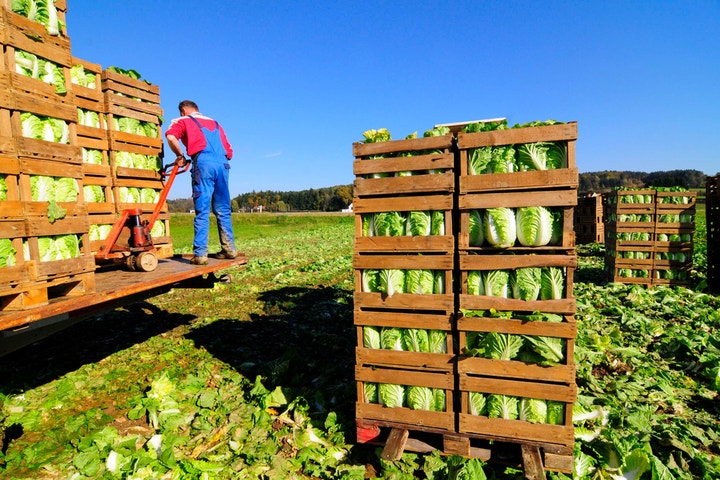
A new climate study published in Nature points to a steep decline in global crop yields over the coming decades, and puts the U.S. farm belt directly in the crosshairs.
In a recent interview with CNN, Solomon Hsiang, a Stanford economist and lead author of the study, made it clear: "As a species, we have never confronted anything like this."
The eight-year study analyzed six staple crops: corn, soybeans, wheat, rice, cassava, and sorghum across more than 12,000 regions in 54 countries. These crops account for over two-thirds of the world's daily calories. For each additional degree of warming, global food output is projected to fall by the equivalent of 120 calories per person, per day.
If current emissions trends hold, the world is on pace to warm by around 3°C this century. That would take a 360-calorie chunk out of the global diet—roughly the value of an average breakfast, as Hsiang put it.
U.S. Crop Yields Face Sharp Declines
While developing countries often bear the brunt of climate impacts, this study suggests some of the hardest hits will fall on developed agricultural economies. In the U.S., crop yields for corn, soybeans, and wheat could drop by 40% to 50%. Soybeans are expected to take the largest hit, with yields down by half under high-warming scenarios.
The problem, researchers say, is that modern agriculture in the U.S. is built around stable, temperate climate conditions. As weather patterns become more extreme, regions like the Midwest, where corn and soy dominate, become increasingly exposed.
Andrew Hultgren, an agricultural economist at the University of Illinois Urbana-Champaign and co-author of the study, told CNN: "You do start to wonder if the Corn Belt is going to be the Corn Belt in the future."
While some adaptation is already underway, such as shifting planting zones northward, those changes aren't expected to offset the full impact. The report suggests that adaptation helps, but it doesn't solve the problem.
Don't Miss: Wall Street has been quietly buying up equity in owner-occupied homes, and the strategy is kind of genius. Here's how one company is using it to produce 15%+ annual returns for its investors.
U.S. Farmland Is Shrinking, Too
Adding pressure to an already strained system, the total amount of land in farm use continues to fall.
According to USDA data, the U.S. lost 2.1 million acres of farmland in 2024. That brings the total down to 876.5 million acres, roughly 14 million fewer than a decade ago. The number of operating farms also fell again, dropping by nearly 15,000 year-over-year.
Fewer farms, less land, and lower yields. That's the setup heading into what many scientists now see as a long-term structural challenge to food production.
Agricultural Commodities May Offer a Hedge
The shift has caught the attention of investors looking to protect against long-term supply disruptions and rising food prices.
One option gaining interest is the Teucrium Agricultural Fund (NYSE:TAGS), an ETF designed to give investors direct exposure to futures contracts tied to corn, soybeans, wheat, and sugar.
Unlike farmland REITs or agribusiness stocks, which are influenced by broader market forces, commodity ETFs like TAGS provide direct access to price movements in the underlying crops themselves. That distinction matters when supply shocks, like crop failures or climate-driven shortages, hit.
For more targeted exposure, investors can look to Teucrium's lineup of single-commodity ETFs, which include funds focused exclusively on corn, soybeans, wheat or sugar. These can be used tactically, especially as new data emerges about which regions and crops are most vulnerable.
With global demand still rising, driven by population growth and dietary shifts in emerging markets, the long-term need for efficient food production isn't going anywhere. But the supply side is entering unfamiliar territory.
Hsiang told CNN, "This is a major problem. It's incredibly expensive." And it's one the world can't afford to ignore much longer.
Finding Stability When the World Feels Anything But
Systemic risks like climate change and increasing food demand don't just affect crops or commodities. They ripple through every sector, every portfolio and every plan for the future.
That's why more investors are shifting part of their strategy toward assets that aren't tied to the public markets at all.
The U.S. Home Equity Fund from Homeshares offers exposure to a $34 trillion asset class: the equity inside U.S. homes. It's not subject to the same volatility as stocks or commodities. It doesn't rely on monthly rent checks and isn't waiting for interest rates to fall. And because it's structured for growth with downside protections in place, it's built to weather uncertainty without needing the world to behave.
In a time when food, fuel, and financial markets are all being tested, home equity offers something rare: resilience.
See how Homeshares is helping investors tap into the value of U.S. home equity.
Image: Shutterstock







